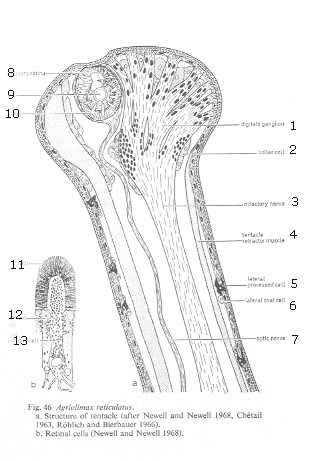As you've read in my previous posts, a slug sees through two tiny eyes, which are situated atop stalks extending out from its head. These comprise the cephalic tentacles, derived from the Greek word kephalē, meaning "head." Like many gastropods, three-band slugs do not rely on vision to understand and interact with their environment. Instead, they use touch and smell to navigate their world, locate food, and find a mate. Consequently they can only differentiate between light and dark; they can't see the details of objects like other animals can. And in truth, they don't really need to. Three-banded slugs are herbivores, so their "prey" is not something that can elude them. They spend a great deal of time eating, and if they're not doing that they're resting or seeking a mate. Moreover, they're nocturnal creatures; you'll have to look hard to find them during the day, though many times all you have to do is turn over a stepping stone or potted plant and you'll see them snuggled in the dirt, comfortably moist from the water in the soil and the mucus they secrete, and in the company of snails, worms, and centipedes.
Here is a diagram showing the eye of Agriolimax reticulatum, the gray garden slug, which resembles that of Lehmannia valentiana.
1.digitate ganglion
2.collar cell
3.olfactory nerve
4.tentacle retractor muscle
5.lateral processed cell
6.lateral oval cell
7.optic nerve
8.accessory retina
9.lens
10.retina
retinal cell:
11.microvilli
12.pigment cell
13.light sensitive cell
In addition to photoreceptor cells, the cephalic tentacles also have tactile cells (for touch) and chemoreceptor cells (for processing chemical signals, such as scents, which is necessary to identify fellow slugs, since one slug can't actually see another, and food). These cells cover the slug's body as well, making it sensitive to light and chemicals from more than one direction. The slug responds to these stimuli by moving either away from or towards them, and sometimes by retracting their tentacles and staying put.
Here are a couple of close-up photos I've taken:
So, just imagine for a moment what life is like for a slug. They can barely see, they can't hear at all, and they rely mostly on touch and smell. Their "brain" is but a nerve ring around their esophagus (as shown in the last post). And yet they do exactly as God commands them: "be fruitful and multiply". Somehow, in their dark, shapeless world, they're able to find food and a mate. They glorify Him simply by existing, being a testament to His awesomeness.



No comments:
Post a Comment